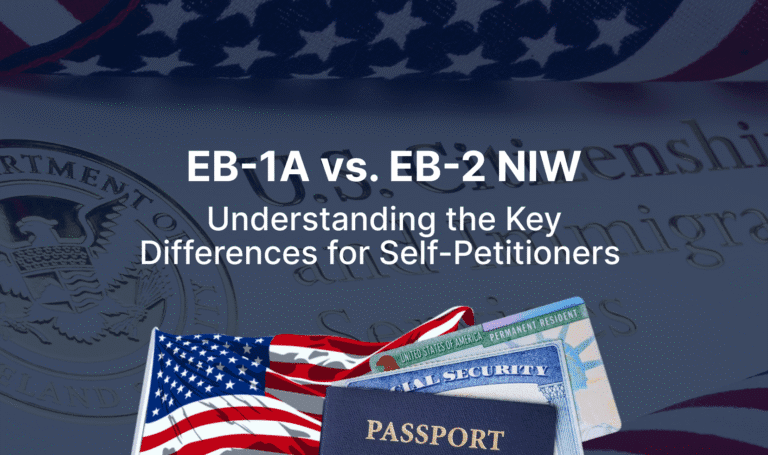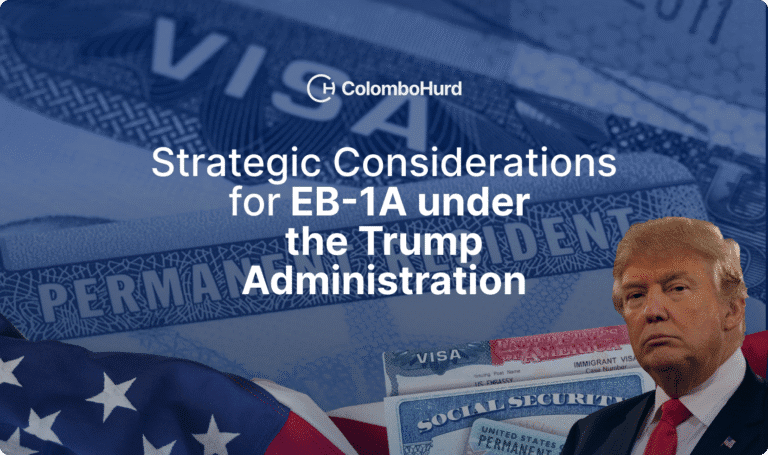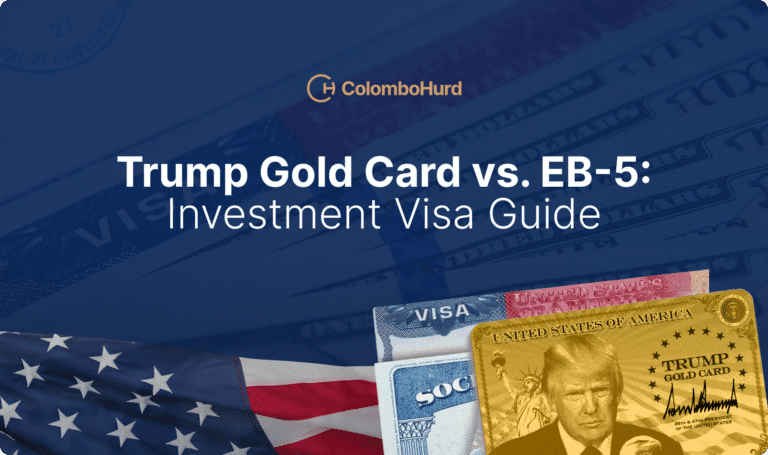Entering the United States through investment is possible under two primary visa options: the E-2 Treaty Investor Visa and the EB-5 Immigrant Investor Program. While both involve investing in a U.S. business, they are designed for very different types of investors and lead to different immigration outcomes.
- The E-2 is a temporary investor visa that offers faster entry, lower investment thresholds, and active business management. While it does not directly provide a green card, it does provide for multiple renewals.
- The EB-5 is a permanent residency program that leads to a U.S. green card, requiring a larger investment and job creation under specific federal guidelines.
At Colombo & Hurd, we work with investors across a range of industries and backgrounds to determine how to qualify and how to position each investment to support both business growth and immigration goals.
This guide breaks down the core differences between EB-5 and E-2, including investment requirements, timelines, management responsibilities, and pathways to permanent residency.
EB-5 vs. E-2 Visa: Key Differences at a Glance
| Feature | E-2 Visa | EB-5 Visa |
| Type | Nonimmigrant (temporary) | Immigrant (green card) |
| Minimum Investment | ~$100,000 (practice-driven threshold, depends on business) | $800,000/$1.05M |
| Job Creation | Not fixed; business must be more than marginal | 10 full-time U.S. jobs required |
| Country Eligibility | Treaty countries only (citizenship-based) | Open to all nationalities |
| Path to Green Card | Indirect (e.g., EB-2 NIW or later EB-5) | Direct (immigrant visa) |
| Processing Time | Generally faster (post-dependent) | Longer/multiple steps, improving with reforms |
| Role in the Business | Active: develop & direct operations | Managed by Regional Center; Direct EB-5 can be active |
| Validity/Travel | Visa validity often up to 5 years; 2-year status per entry; renewable | Permanent residence allows for international travel |
What is the E-2 Treaty Investor Visa?
The E-2 visa allows investors from treaty countries to start or acquire a U.S. business and actively manage it. Eligibility depends on citizenship, not birthplace, so someone born in Brazil, for example, may still qualify if they hold Italian or Spanish citizenship.
To qualify for an E-2, you must:
- Invest a substantial amount (commonly around $100,000 or more depending on the business model).
- Own at least 50% of the business or maintain control through a management role.
- Actively direct the business, passive investment is not enough.
- Show that funds are lawfully sourced and fully committed (at risk).
- Prove the business is real, active, and more than marginal, meaning it will create value and jobs over time.
Benefits
The E-2 visa is typically valid for up to 5 years at a time and can be renewed indefinitely. Investors may live in the U.S. with their spouses and unmarried children under 21. Spouses also receive work authorization.
Limitation
The E-2 visa does not provide a green card on its own. Investors who want permanent residency must transition later through EB-5, EB-2 NIW, or another category.
What is the EB-5 Immigrant Investor Program?
The EB-5 visa is a direct path to a U.S. green card through investment. Unlike the E-2, it is open to all nationalities.
To qualify for EB-5, you must:
- Invest $800,000 USD in a Targeted Employment Area (TEA) (rural or high-unemployment area)
- OR $1,050,000 USD in a non-TEA project
- Create 10 full-time U.S. jobs
- Prove lawful source and path of funds
- Keep the investment at risk during the process
There are two investment paths under EB-5:
- Regional Center investment (most common): pooled investment model managed by professionals; jobs are counted indirectly.
- Direct EB-5 investment: Investor runs or manages the business directly while creating 10 jobs directly.
Benefits
The program provides conditional green cards first, followed by full permanent residency after job creation is confirmed. Since 2022 immigration reforms, EB-5 now allows concurrent filing of green card applications in the U.S., which lets investors already in the U.S. apply for permanent residency and obtain a temporary work permit and travel permit while the EB-5 case is pending.
Limitation
The EB-5 program requires a higher investment and strict proof of job creation and source of funds. Processing can take longer than E-2, and funds must remain at risk until USCIS adjudication is complete.
Investment Requirements Compared
The E-2 visa offers lower entry costs. Although there is no official minimum investment, U.S. consulates require proof of a credible business with sufficient funding to begin operations. In practice, most successful E-2 cases start around $100,000 USD. Funds must be fully committed at the time of filing, meaning they should already be invested in legitimate startup expenses such as equipment, leases, payroll, or committed to the purchase of an existing business or franchise fees.
The EB-5 program requires a larger financial commitment, $800,000 USD in a TEA project or $1,050,000 USD outside a TEA. Unlike E-2, EB-5 requires formal evidence of job creation and a lawful source and path of funds. This makes financial documentation more complex but offers a significant benefit: a direct path to permanent residency.
Business Involvement & Management
A key difference between the two programs is how involved the investor must be in the U.S. business. If your goal is to own and run a business in the U.S., the E-2 may be a better fit. If you prefer a more investment-only approach without day-to-day management responsibilities, EB-5 provides a more suitable structure, especially through government-approved Regional Centers.
E-2 Investor Involvement
- The investor must actively direct and manage the business.
- Day-to-day decision-making or executive-level oversight is required.
- Passive investments are not allowed.
- The investor must demonstrate a real operational role through an organizational chart, job description, or management plan.
- Suitable for entrepreneurs, business owners, and hands-on operators.
EB-5 Investor Involvement
- Regional Center investment: Pooled investment model managed by professionals.
- Direct EB-5 investment: Investor runs or manages the business directly while creating 10 jobs directly.
- No day-to-day management or operational role is required.
- Suitable for investors seeking a hands-off approach while still obtaining U.S. permanent residency through investment.
| Topic | E-2 Visa | EB-5 Visa |
| Business Role | Active management required | Shareholder or limited partner in a pool of investors (Regioanl Center Model), or owner of a business (Direct Model) |
| Ideal for | Entrepreneurs and operators | Investors seeking residency through capital |
| Time Commitment | Daily or executive decision-making | Limited or policy-level involvement |
Pathways to Permanent Residency
While the EB-5 visa directly grants a green card, the E-2 can be the first step in a long-term residency strategy. Many of our clients follow a step-by-step approach:
E-2 → EB-5
Start with a $100K+ E-2 business, grow it, continue investments to meet EB-5 requirements of $800K and 10 jobs. This staged approach reduces financial risk.
E-2 → EB-2 National Interest Waiver (NIW)
If your business contributes to efforts that lead to U.S. economic or social advancement—such as healthcare, environmental solutions, or workforce development—and you possess high levels of education and experience, you may qualify for a self-sponsored green card.
EB-5 Direct Path
For investors ready to commit now, EB-5 offers permanent residency for the investor, spouse, and children under 21.
Processing Time & Case Strategy
Processing times are often a deciding factor for investors choosing between the E-2 and EB-5 options. Generally, the E-2 visa offers faster entry into the United States, while EB-5 may be a longer process but leads directly to permanent residency.
E-2 Processing Timeline
The E-2 timeline depends heavily on the U.S. Embassy or Consulate where the investor applies, as each post has its own processing system. Some consulates can schedule an interview within a few weeks, while others may take two to three months or more. For investors already in the United States, it is also possible to change status to E-2 through USCIS, which typically takes 2–4 months with premium processing. Because there is no annual cap on E-2 visas, applicants are not affected by visa backlogs.
EB-5 Processing Timeline
Historically, EB-5 processing could take several years, but recent policy reforms have significantly improved timelines, especially for new Regional Center filings. Since 2022, EB-5 investors who are already inside the United States can take advantage of concurrent filing, which allows them to submit the green card application (Form I-485) at the same time as the EB-5 petition (Form I-526E). As a result, they can receive work and travel authorization in approximately 6 to 9 months, even while their EB-5 petition is still pending. Many investors can begin receiving immigration benefits in as little as 12 to 18 months when filing from inside the U.S.
For investors who are outside the United States, concurrent filing is not available. Instead, consular processing is required, which typically results in a longer waiting period before receiving immigration benefits. In most cases, these petitioners can expect to move forward based on EB-5 petition approval and visa availability, which may take 18 to 30 months or longer, depending on the case and country of origin.
Country-Based Considerations: Investors from India and China have experienced EB-5 backlogs in previous years due to visa demand. However, investing in rural or infrastructure projects can now allow investors from these countries to avoid visa delays thanks to set-aside visa categories created under the EB-5 Reform and Integrity Act.
Common Misconceptions
Let’s clear up a few common misconceptions:
Myth 1: “The E-2 leads to a green card automatically.”
Fact: The E-2 is temporary but it can be a bridge to permanent residency with the right planning.
Myth 2: “You must invest exactly $100K for E-2.”
Fact: There is no fixed minimum, but your investment must be enough to launch and operate a real business.
Myth 3: “EB-5 guarantees a green card if you invest”
Fact: Funding alone isn’t enough, you must prove lawful funds and job creation.
Myth 4: “EB-5 takes too long”
Fact: Timelines have improved with concurrent filing and visa set-asides for rural projects, and concurrent green card processing can provide benefits even while cases are pending approval.
Myth 5: “I can invest so my child gets the visa without moving to the U.S. myself”
Fact: The investor must qualify and participate. These visas are not a way to buy status for dependents only, but many do plan for a child in college to make an investment.
Real Investor Case Studies
EB-5: South American Investor – Green Card Through Hospitality
We secured EB-5 approval for a South American investor who funded a $800,000 hospitality development in a TEA. We documented lawful multi-generational funds and established job creation compliance. USCIS approved the petition with no RFE, putting the client on a direct path to U.S. residency.
E-2: German Entrepreneur – Digital Media Company in Florida
We obtained E-2 approval for a German investor who launched a media company in Florida with over 226,000 global subscribers. After making a substantial investment and demonstrating active management, he and his family were approved by the U.S. Consulate in Frankfurt and successfully relocated.
E-2: Spanish Investor – Eco-Sanitation Startup in Texas
We also secured E-2 approval for a Spanish investor who established a green sanitation company in Texas. He owned 100% of the business and implemented an environmental impact model, satisfying all E-2 eligibility criteria and receiving approval through Change of Status.
Conclusion: Choosing the Right Path
Both the E-2 visa and the EB-5 program are powerful tools for building a future in the United States, but neither should be approached casually. These are complex immigration processes that require planning, documentation, and commitment. In my experience, the investors who succeed are the ones who treat this as a strategic process, not just filling out paperwork.
Whether your goal is speed through E-2 or permanent residency through EB-5, the right path depends on your business plan, source of funds, nationality, and long-term goals. You shouldn’t make this decision alone or based on assumptions. At Colombo & Hurd we build custom immigration strategies that protect both your investment and your future in the United States.
Find out which is the right visa pathway for you. See how we can help.



